Корни персонажей Д.Р.Р.Толкиена
Gymnasium №2
The roots of some Tolkien’s characters.
Tolkien’s view on some events from the Bible
and archaic history.
Name: Yanov Andrey
Teacher: Mordasova L.M.
Voronezh 2004
CONTENTS
I. Introduction 3
II. Body
1. J.R.R.Tolkien: A biographical sketch
a) Tolkien’s birth 4
b) Tolkien’s childhood in South Africa 4
c) Tolkien's childhood in England 4
d) Tolkien's childhood fears 4
e) Tolkien's education at home 5
f) Tolkien's childhood books 5
g) Tolkien in elementary school 6
h) Tolkien learns some philology 6
i) Tolkien's mother dies 6
j) Tolkien in high school 7
k) Tolkien in Oxford 7
l) Tolkien after World War II 9
m) Tolkien now 10
2. The roots of some Tolkien characters 11
3. Tolkiens view on some events from
The Bible and archaic history 15
III. Conclusion 19
IV. List of used literature 20
V. Appendix 21
Introduction
I have many hobbies and one of them is reading. I like to read. Books liberalize us, and it is just very interesting. My favorite kinds of literature are fantasy, science fiction, myths and historical books. But when I saw the film “The Lord Of The Rings” for the first time, I liked it very much. I realized that there was something unusual in it that attracted me. One day someone told me, that this film is a screen version of the book, written by Tolkien. Then I decided to read the book. And when I read its last page, I realized, that the world, that was described there is very close to me. That is how my keening of Tolkien’s works started. I’ve read the whole “The Lord Of The Rings”, “The Silmarillion”, “The Hobbit Or There And Back Again”, some Tolkien’s poems, such as “Namarie” (which means “farewell” in the “Quenya Lambe” (The Elvish Language)), “Oh, queen beyond the western sees…” and other works. Besides I’ve read “The Biography Of J.R.R.Tolkien”, written by H. Carpenter and many works of different famous critics devoted to Tolkien. While reading such literature, I understand and realize very interesting ideas of Tolkien, his philosophy, and it is very interesting to know, what things influenced the creation of his characters and his own world that he developed in “The Silmarillion”. And in my work I’m trying to show you just some of those things.
J.R.R.Tolkien: A biographical sketch
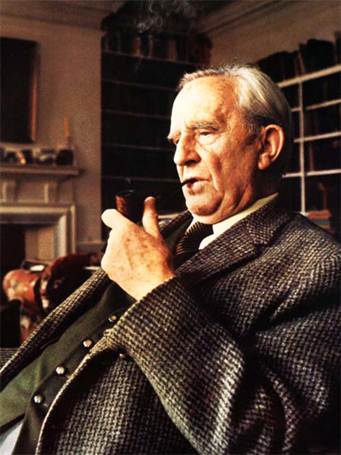 Tolkien's birth
Tolkien's birth
John Ronald Reuel Tolkien was born to Mabel Suffield and Arthur Tolkien in South Africa on January 3, 1892.
On February 17,1894, Mabel gave birth to Hilary Arthur Reuel Tolkien, J.R.R's only brother.
When Ronald (J.R.R)'s health worsened in 1895, the Tolkiens (except for Arthur, who had to stay in order to wrap up business) left to Southampton.
On February 15, 1896, Arthur Tolkien, in South Africa, died due to a severe hemorrhage.
Tolkien's childhood in South Africa
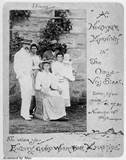 ". . . many months later, when Ronald was beginning to walk, he stumbled on a tarantula. It bit him, and he ran in terror across the garden until the nurse snatched him up and sucked out the poison . . . Nevertheless, in his stories he writes more than once of monstrous spiders with venomous bites" (Carpenter 14)
". . . many months later, when Ronald was beginning to walk, he stumbled on a tarantula. It bit him, and he ran in terror across the garden until the nurse snatched him up and sucked out the poison . . . Nevertheless, in his stories he writes more than once of monstrous spiders with venomous bites" (Carpenter 14)
 "During the first year of the boy's life Arthur Tolkien made a small grove of cypresses, firs and cedars. Perhaps this had something to do with the deep love of trees that wood that would develop in Ronald" (Carpenter 14)
"During the first year of the boy's life Arthur Tolkien made a small grove of cypresses, firs and cedars. Perhaps this had something to do with the deep love of trees that wood that would develop in Ronald" (Carpenter 14)
Tolkien's childhood in England
Since his father (the sole source of money) was dead, J.R.R. and his family went to live with the Suffields (his maternal grandparents).
In the summer of 1896, the Tolkiens moved out of Birmingham to the hamlet of Sarehole (located in the English countryside).
Tolkien's childhood fears
"An old farmer who once chased Ronald for picking mushrooms was given the nickname 'The Black Ogre' by the boys . . . they began to pick up something of the local vocabulary, adopting dialect words into their own speech: 'chawl' for a cheek of pork, 'miskin' for dustbin, 'pickelet' for crumpet, and 'gamgee' for cotton wool. (Carpenter 21)
Tolkien's education at home
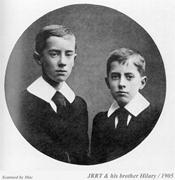 "Mabel soon began to educate her sons, and they could have had no better teacher - nor she an apter pupil than Ronald, who could read by the time he was four and had soon learnt to write proficiently." (Carpenter 21).
"Mabel soon began to educate her sons, and they could have had no better teacher - nor she an apter pupil than Ronald, who could read by the time he was four and had soon learnt to write proficiently." (Carpenter 21).
![]() ". . . his favorite lessons were those that concerned languages. Early in his Sarehole days, his mother introduced him to the rudiments of Latin, and this delighted him. He was just as interested in the sounds of the words as their meanings, and she began to realize that he had a special aptitude for language. (Carpenter 22).
". . . his favorite lessons were those that concerned languages. Early in his Sarehole days, his mother introduced him to the rudiments of Latin, and this delighted him. He was just as interested in the sounds of the words as their meanings, and she began to realize that he had a special aptitude for language. (Carpenter 22).
"His mother taught him a great deal of botany, and he responded to this and soon became very knowledgeable. But again he was more interested in the shape and feel of a plant than in its botanical details. This was especially true of trees. And though he liked drawing trees he liked most of all to be with trees. He would climb them, lean against them, even talk to them." (Carpenter 22)
Tolkien's childhood books
"He was amused by Alice in Wonderland, though he had no desire to have adventures like Alice. He did not enjoy Treasure Island, nor the stories of Hans Anderson, nor The Pied Piper. But he liked Red Indian stories and longed to shoot with a bow and arrow. He was even more pleased by the 'Curdie' books of George Macdonald, which were set in a remote kingdom where misshapen and malevolent goblins lurked beneath the mountains. The Arthurian legends also excited him. But most of all he found delight in the Fairy Books of Andrew Lang, especially the Red Fairy Book, for tucked away in its closing pages was the best story he had ever read. This was the tale of Sigurd who slew the dragon Fafnir: a strange and powerful tale set in the nameless North." (Carpenter 22)
Tolkien's first experience with grammer
"'I desired dragons with a profound desire,', he said long afterwards. . . . When he was about seven he began to compose his own story about a dragon. 'I remember nothing about it except a philological fact,' he recalled. 'My mother said nothing about the dragon, but pointed out that one could not say 'a green great dragon', but had to say 'a great green dragon'. I wondered why, and still do. The fact that I remember this is possibly significant, as I do not think I ever tried to write a story again for many years, and was taken up with language.'" (Carpenter 24)
Tolkien in elementary school
In September of 1900, J.R.R. Tolkien entered into King Edward's School.
In order to prevent Ronald from walking several miles between the countryside home and school, the Tolkiens moved from Sarehole to Birmingham.
Due to school conflicts, Ronald Tolkien was transferred to King Phillip's Academy for a short period.
Tolkien learns some philology
". . . he especially remembered 'the bitter disappointment and disgust from schooldays with the shabby use made in Shakespeare of the coming of 'Great Birnam Wood to high Dunisiane hill'; 'I longed to devise a setting by which the trees might really march to war" (Carpenter 28)
"By inclination, his form-master Brewerton was a medievalist . . . if a boy employed the term 'manure' Brewerton would roar out: 'Manure? Call it muck! Say it three times! Muck, muck muck!'. He encouraged his students to read Chaucer, and he recited the Canterbury Tales to them in the original Middle English. To Ronald Tolkien's ears, this was a revelation, and he determined to learn more about the history of the language." (Carpenter 28)
Tolkien's mother dies
"The New Year (1904) did not begin well. Ronald and Hilary were confined to bed with measles followed by whooping-cough, and in Hilary's case by pneumonia. The addition strain of nursing them proved too much for their mother, and as she feard it proved 'impossible to go on'. By April 1904 she was in hospital, and her condition was diagnosed as diabetes." (Carpenter 29)
"At the beginning of November 1904, she sank into a diabetic coma, and six days later, on November 14, she died." (Carpenter 30)
". . . Perhaps his mother's death also had a cementing effect on his study of languages. It was she, after all, who had been his first teacher and who had encouraged him to take an interest in words. Now that she was gone he would pursue that path relentlessly. And certainly the loss of his mother had a profound effect on his personality. It made him into a pessimist . . . Nothing was safe. Nothing would last. No battle would be won for ever." (Carpenter 31)
Related to philosophy of THE LORD OF THE RINGS: Middle-Earth is never, ever free from evil. The Simillirion states that Middle-Earth is destroyed and all live in Valinor (quasi Middle-Earth) after the death of Morgroth (by Turin, son of Thor).
Tolkien lives with his mother's aunt-in-law (in urban Edgbaston) along with his brother Hillary.
"His feelings towards the rural landscape, already sharp from the earlier severance that had taken him from Sarehole, now become emotionally charged with personal bereavement. This love for the memory of the countryside of his youth was later to become a central part of his writing, and it was intimately bound up with his love for the memory of his mother." (Carpenter 32-3)
Tolkien in high school
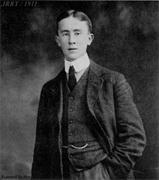 "Headmaster Gilson also encouraged his pupils to make a detailed study of classical linguistics. This was entirely in keeping with Tolkien's inclinations; and, partly as a result in the general principles of language" (Carpenter 34)
"Headmaster Gilson also encouraged his pupils to make a detailed study of classical linguistics. This was entirely in keeping with Tolkien's inclinations; and, partly as a result in the general principles of language" (Carpenter 34)
 "It was one thing to know Latin, Greek, French, and German; it was another to understand why they were what they were. Tolkien had started to look for the bones, the elements that were common to them all: he had begun, in fact, to study philology, the science of words." (Carpenter 34)
"It was one thing to know Latin, Greek, French, and German; it was another to understand why they were what they were. Tolkien had started to look for the bones, the elements that were common to them all: he had begun, in fact, to study philology, the science of words." (Carpenter 34)
Tolkien studies all languages (Studies Chaucer, Beowulf, Old Norse, Gothic)
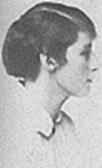 "He continued his search for the 'bones' behind all these languages, rummaging in the school library and exploring the remoter shelves of Cornish's bookshop down the road. Eventually he began to find - and to scrape enough money to buy - German books on philology that were 'dry-as-dust' but which could provide the answers to his questions. Philology: 'the love of words'. For that was what motivated him. It was not an arid interest in the scientific principles of language; it was a deep love for the look and sound of words, springing from the days when his mother had given him his first Latin lessons . . . And as a result of this love of words, he had started to invent his own words" (Carpenter 35) Tolkien begins to (at age 14) to create his own languages, namely 'Nevbosh', a language filled with Gothic and Norse words.
"He continued his search for the 'bones' behind all these languages, rummaging in the school library and exploring the remoter shelves of Cornish's bookshop down the road. Eventually he began to find - and to scrape enough money to buy - German books on philology that were 'dry-as-dust' but which could provide the answers to his questions. Philology: 'the love of words'. For that was what motivated him. It was not an arid interest in the scientific principles of language; it was a deep love for the look and sound of words, springing from the days when his mother had given him his first Latin lessons . . . And as a result of this love of words, he had started to invent his own words" (Carpenter 35) Tolkien begins to (at age 14) to create his own languages, namely 'Nevbosh', a language filled with Gothic and Norse words.
![]() 1908 - Tolkien falls in love with Edith Bratt
1908 - Tolkien falls in love with Edith Bratt
1911 -Tolkien starts the Tea Club and goes to Switzerland
Tolkien in Oxford
In 1911 Tolkien entered Exeter College of Oxford. There he started writing (poem 'Wood-sunshine'), modeled after several different authors.
"In 'Wood-sunshine' there is a distinct resemblance to an episode in the first part of Thompson's 'Sister Songs' where the poet sees first a single elf and then a swarm of woodland sprites in the glade; when he moves, they vanish . . ." (Carpenter 48)
"Being taught by Joe Wright, Tolkien managed to find books of medieval Welsh, and he began to read the language that had fascinated him since he saw a few words of it on coal-trucks. He was not disappointed; indeed he was confirmed in all his expectations of beauty. Beauty: that was what pleased him in Welsh; the appearance and sound of the words almost irrespective of their meaning. He once said: 'Most English-speaking people, for instance, will admit that cellar door is 'beautiful', especially if disassociated from its sense (and its spelling). More beautiful than, say sky, and far more beautiful than beautiful'." (Carpenter 56-7)
Tolkien starts advanced languages (new): "He abandoned neo-Gothic and began to create a private language that was heavily influenced by Finnish. This was the language that would eventually emerge in his stories as 'Quenya' or High-elven. That would not happen for many years; yet already a seed of what was to come was germinating in his mind" (Carpenter 59)
1913 - Tolkien graduates from three-year program with second-class honors and proceeds to study philology in graduate school.
At the same period Tolkien reads Cynewulf - "'I felt a curious thrill,' he wrote long afterwards, 'as if something had stirred in me, half wakened from sleep. There was something very remote and strange and beautiful behind those words, if I could grasp it, far beyond ancient English'." (Carpenter 64) Tolkien reads the Völuspa - "The most remarkable of all Germanic-mythological poems, it dates from the very end of Norse heathendom, when Christianity was taking the place of the old gods; yet it imparts a sense of living myth, a feeling of awe and mystery, in its representation of a pagan cosmos. It had a profound appeal to Tolkien's imagination" (Carpenter 65) Tolkien sees Edith again (he was previously banned to see him by Father Francis, his guardian)
Tolkien reads Morris (NOTE: Mirkwood is the name of the great Necromancer's forest in The Hobbit and the Lord of the Rings trilogy) "Written partly in prose and partly in verse, (Morris's book) centers on a House or family-tribe that dwells by a great river in a clearing of the forest named Mirkwood, a name taken from ancient Germanic geography and legend. Many elements in the story seem to have impressed Tolkien. It's style is highly idiosyncratic, heavily laden with archaisms and poetic inversions in an attempt to recreate the aura of ancient legend. Clearly Tolkien took not of this, and it would seem that he also appreciated another facet of the writing: Morris' aptitude, despite the vagueness of time and place in which the story is set, for describing with great precision the details of his imagined landscape. Tolkien himself was to follow Morris' example in later year." (Carpenter 70)
In the same year Tolkien visits Cornwall (NOTE: This is the location for the Sea in The Hobbit and LOTR) " 'Nothing I could say . . . could describe it to you. The sun beats down on you and a huge Atlantic swell smashes and spouts over the snags and reefs. The sea has carved weird wind-holes and spouts into the cliffs which blow with trumpety noises or spout foam like a whale, and everywhere you see black and red rock and white foam against violet and transparent seagreen.'." (Carpenter 70)
Tolkien begins to create works with Quentya (language of the high-elves): "He had been working for some time at the language that was influenced by Finish, and by 1915 he had developed it to a degree of some complexity. He felt that it was 'a mad hobby', and he scarcely expected to find an audience for it. But he sometimes wrote poems n it, and the more he worked at it the more he felt that it needed a 'history' to support it. In other words, you cannot have a language without a race of people to speak it. He was perfecting the language; now he had to decide to whom it belonged." (Carpenter 75)
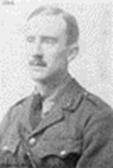 Tolkien creates Valinor (Land of the Gods in the Silmarillion) "This, he decided, was the language by the fairies or elves whom Earendel saw during his strange voyage. He began work on a 'Lay of Earendel' that described the mariner's journeying across the world before his ship became a star. The Lay was to be divided into several poems, and the first of these, 'The shores of Faery', tells of the mysterious land of Valinor, where Two Trees grow, one bearing golden sun-apples and the other silver moon-apples." (Carpenter 76)
Tolkien creates Valinor (Land of the Gods in the Silmarillion) "This, he decided, was the language by the fairies or elves whom Earendel saw during his strange voyage. He began work on a 'Lay of Earendel' that described the mariner's journeying across the world before his ship became a star. The Lay was to be divided into several poems, and the first of these, 'The shores of Faery', tells of the mysterious land of Valinor, where Two Trees grow, one bearing golden sun-apples and the other silver moon-apples." (Carpenter 76)
 1916 - Tolkien marries Edith, continues war, and gets to know soldiers (Tolkien is an officer). All of Tolkien's friends die (except C.S. Lewis)
1916 - Tolkien marries Edith, continues war, and gets to know soldiers (Tolkien is an officer). All of Tolkien's friends die (except C.S. Lewis)
Tolkien after World War II
Continuing the last wishes of the T.B.C.S (the society he had founded with his friends at St. Edwards), Tolkien decides to create a whole society.
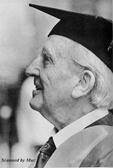 (Founding precepts of the LOTR) " 'I (Tolkien) had a mind to make a body of more or less connected legend, ranging from the large and cosmogonic to the level of romantic fairy-story - the larger founded on the lesser in contact with the earth, the lesser drawing splendor from the vast backcloths - which I could dedicate simply: to England; to my country. It could possess the tone and quality that I desired, somewhat cool and clear, be redolent of our 'air' (the clime and soil of the North West, meaning Britain and the hither parts of Europe; not Italy or the Aegean, still less the East), and, while possessing (if I could achieve it) the fair elusive beauty that some call Celtic (though it is rarely found in genuine ancient Celtic things), it should be 'high', purged of the gross, and fit for the more adult mind of a land long steeped in poetry, I would draw some of the great tales in fullness, and leave many only placed in the scheme, and sketched. The cycles should be linked to a majestic whole, and yet leave scope for other minds and hands, wielding paint and music and drama" (Carpenter 90) (Researching, not inventing) "When he wrote The Silmarillion Tolkien believed that in one sense he was writing the truth. He did not suppose that precisely such peoples as he described, 'elves', 'dwarves', and malevolent 'orcs', had walked the earth and done the deeds that he recorded. But he did feel, or hope, that his stories were in some sense an embodiment of a profound truth . . . Tolkien believed that he was doing more than inventing a story. He wrote of the tales that make up the book: 'They arose in my mind as 'given' things, and as they came, separately, so too the links grew . . . yet always I had the sense of recording what was already 'there', somewhere: not of 'inventing'." (Carpenter 91-2)
(Founding precepts of the LOTR) " 'I (Tolkien) had a mind to make a body of more or less connected legend, ranging from the large and cosmogonic to the level of romantic fairy-story - the larger founded on the lesser in contact with the earth, the lesser drawing splendor from the vast backcloths - which I could dedicate simply: to England; to my country. It could possess the tone and quality that I desired, somewhat cool and clear, be redolent of our 'air' (the clime and soil of the North West, meaning Britain and the hither parts of Europe; not Italy or the Aegean, still less the East), and, while possessing (if I could achieve it) the fair elusive beauty that some call Celtic (though it is rarely found in genuine ancient Celtic things), it should be 'high', purged of the gross, and fit for the more adult mind of a land long steeped in poetry, I would draw some of the great tales in fullness, and leave many only placed in the scheme, and sketched. The cycles should be linked to a majestic whole, and yet leave scope for other minds and hands, wielding paint and music and drama" (Carpenter 90) (Researching, not inventing) "When he wrote The Silmarillion Tolkien believed that in one sense he was writing the truth. He did not suppose that precisely such peoples as he described, 'elves', 'dwarves', and malevolent 'orcs', had walked the earth and done the deeds that he recorded. But he did feel, or hope, that his stories were in some sense an embodiment of a profound truth . . . Tolkien believed that he was doing more than inventing a story. He wrote of the tales that make up the book: 'They arose in my mind as 'given' things, and as they came, separately, so too the links grew . . . yet always I had the sense of recording what was already 'there', somewhere: not of 'inventing'." (Carpenter 91-2)
 Influences from language: "As to the names of persons and places in 'The Fall of Gondolin' and the other stories in The Silmarillion, they were constructed from Tolkien's invented languages. Since the existence of these languages was a raison d'être for the whole mythology, it is not surprising that he devoted a good deal of attention to the business of making up names from them"
Influences from language: "As to the names of persons and places in 'The Fall of Gondolin' and the other stories in The Silmarillion, they were constructed from Tolkien's invented languages. Since the existence of these languages was a raison d'être for the whole mythology, it is not surprising that he devoted a good deal of attention to the business of making up names from them"
Tolkien creates Sindarin, precursor to Quentya
(Development of 'what is real?') "As the years went by he came more and more to regard his own invented languages and stories as 'real' languages and historical chronicles that needed to be elucidated. In other words, when in this mood he did not say of an apparent contradiction in the narrative or an unsatisfactory name: 'This is not as I wish it to be; I must change it.' Instead he would approach the problem with the attitude: 'What does this mean? I must find about." (Carpenter 94)
On the 16 of November 1917 Tolkien gets a son and writes story of Luthien & Beren
1918 - Tolkien gets job in the OED (Oxford English Dictionary)
1920 - Tolkien gets a professorship at Leeds University
In October of 1920 Tolkien gets second son.
Tolkien writes poems: "Another, 'The Dragon's Visits', describes the ravages of a dragon who arrives at Bimble Bay and encounters 'Miss Biggins'. A third, 'Glip', tells of a strange slimy creature who lives beneath the floor of a cave and has pale luminous eyes" (Carpenter 106) : Dragon ~ Smaug, Miss Biggins ~ Bilbo Baggins, Glip ~ Gollum
1924 - Tolkien gets a third son Christopher.
1925 - Tolkien becomes a professor of Anglo-Saxon at Oxford
1929 - Tolkien gets a daughter
Tolkien now
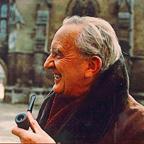
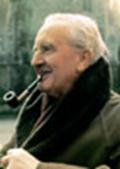 (Tolkien's Workplace) "The shelves are crammed with dictionaries, works on etymology and philology, and editions of texts in many languages, predominant among which are Old and Middle English and Old Norse; but there is also a section devoted to translations of The Lord of the Rings into Polish, Dutch, Danish, Swedish, and Japanese; and the map of his invented 'Middle-Earth' is pinned to the window - ledge." (Carpenter 4) (Tolkien's view of The Lord of the Rings) "He explains it all in great detail, talking about his book not as a work of fiction but as a chronicle of actual events; he seems to see himself not as an author who has made a slight error that must now be corrected or explained away, but as a historian who must cast light on an obscurity in an historical document." (Tolkien's Voice) "He has a strange voice, deep but without resonance, entirely English but with some quality in it I cannot define, as if he had come from another age or civilization" (Carpenter 5)
(Tolkien's Workplace) "The shelves are crammed with dictionaries, works on etymology and philology, and editions of texts in many languages, predominant among which are Old and Middle English and Old Norse; but there is also a section devoted to translations of The Lord of the Rings into Polish, Dutch, Danish, Swedish, and Japanese; and the map of his invented 'Middle-Earth' is pinned to the window - ledge." (Carpenter 4) (Tolkien's view of The Lord of the Rings) "He explains it all in great detail, talking about his book not as a work of fiction but as a chronicle of actual events; he seems to see himself not as an author who has made a slight error that must now be corrected or explained away, but as a historian who must cast light on an obscurity in an historical document." (Tolkien's Voice) "He has a strange voice, deep but without resonance, entirely English but with some quality in it I cannot define, as if he had come from another age or civilization" (Carpenter 5)
The roots of some Tolkien characters
Gandalf
![]()
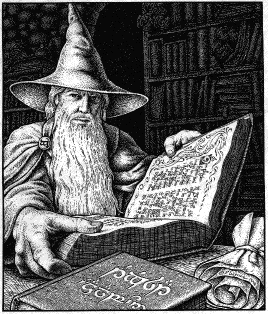 While reading “The Hobbit” and “The Lord Of The Rings” you will meat such character as Gandalf. He is a magician (or Istary in the “The Silmarillion”). And like all magicians he wears a long, thick, grey (or white) beard, a big cone-shaped hat with wide fields and a wide grey raincoat. This character owes with his existence to Tolkien’s trip to Switzerland, where in the shop among the mountans he bought a postcard. It was a reproduction of a picture of a german painter Madlenner, which was called “Der Berggeist” (it could be translated as “The spirit of the mountans”). There was an old man with white long beard and cone-shaped hat with wide fields, who was seating under the tree. Many years later Tolkien wrote on the other side of this postcard the following: “The prototype of Gandalf”…
While reading “The Hobbit” and “The Lord Of The Rings” you will meat such character as Gandalf. He is a magician (or Istary in the “The Silmarillion”). And like all magicians he wears a long, thick, grey (or white) beard, a big cone-shaped hat with wide fields and a wide grey raincoat. This character owes with his existence to Tolkien’s trip to Switzerland, where in the shop among the mountans he bought a postcard. It was a reproduction of a picture of a german painter Madlenner, which was called “Der Berggeist” (it could be translated as “The spirit of the mountans”). There was an old man with white long beard and cone-shaped hat with wide fields, who was seating under the tree. Many years later Tolkien wrote on the other side of this postcard the following: “The prototype of Gandalf”…
Sam Gamgee
Sam Gamgee is a hobbit (It tells us many things). He is the best friend of Frodo and besides that, he is Frodo’s gardener. He is very brave, bonhomous, kind, but careless and light-hearted, and, as all hobbits, he likes to eat very much. It is very interesting, that the word “gamgee” can be translated from one of the English dialects as cotton wool and besides that, it was a surname of a doctor, who had invented 'gamgee-tissue', a surgical dressing made from cotton wool. But the real character of Sam was copied from the character of the mere english soldier of the war of 1914. You already now from the biographical sketch that Tolkien took part in that war. He battled on the front line in France. And he knows, what the war is. Later in one of his letters he wrote: “My Sam Gamgee is indeed a reflection of the English soldier, of the privates and batmen I knew in the 1914 war, and recognized as so far superior to myself”.
Hobbits
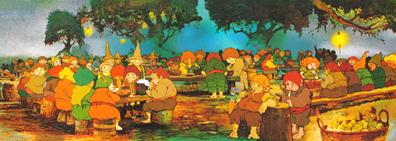 Hobbits is a people of Halflings. They live in holes. They are very short, practical, strait-laced and they like tasty food most of all things in the world. These creatures were created by J.R.R.Tolkien. He was the first, who used them in his books. There are two versions about the origin of the word “hobbit”. V.A. Muravjov keeps one of them. He wrote in his entrance to “The Lord Of The Rings”, that the world “hobbit” is a mixture of latin word “homo”, which means “human” and english word “rabbit”. But Humphrey Carpenter explained the origin of this word in a different way. In his “The biography of J.R.R.Tolkien” he wrote, that in his youth Tolkien read the book “Babbit” by Sincler Luis and it influensed him very much. Carpenter shows us the resemblance of the personality of Babbit and Bilbo Baggins, the main character of Tolkien’s book “The hobbit or there and back again”. Tolkien himself told in one of his interview, that his hobbits have no even a hint on rabbits. That is why I can say, that the second version about the origin of the word “hobbit” is more correct.
Hobbits is a people of Halflings. They live in holes. They are very short, practical, strait-laced and they like tasty food most of all things in the world. These creatures were created by J.R.R.Tolkien. He was the first, who used them in his books. There are two versions about the origin of the word “hobbit”. V.A. Muravjov keeps one of them. He wrote in his entrance to “The Lord Of The Rings”, that the world “hobbit” is a mixture of latin word “homo”, which means “human” and english word “rabbit”. But Humphrey Carpenter explained the origin of this word in a different way. In his “The biography of J.R.R.Tolkien” he wrote, that in his youth Tolkien read the book “Babbit” by Sincler Luis and it influensed him very much. Carpenter shows us the resemblance of the personality of Babbit and Bilbo Baggins, the main character of Tolkien’s book “The hobbit or there and back again”. Tolkien himself told in one of his interview, that his hobbits have no even a hint on rabbits. That is why I can say, that the second version about the origin of the word “hobbit” is more correct.
The Shire
![]()
![]()
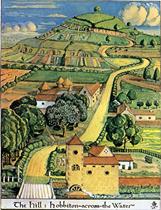
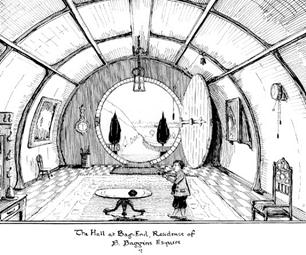 The Shire is a country of hobbits. But it also has its roots. From the biographical sketch we know, that four best years of his childhood Tolkien spent in the village of Sarehole. And wile reading Tolkien’s description of the Shire I realized, that it is very close to the Carpenter’s description of Sarehole. The same water-mill, the same pretty flower-beds, the roads paved with stones of different colors. We can see the festive tree, which was decorated by hobbits every holiday. And we know, that in Sarehole there was a tree, that Tolkien remembered all his life. The first his wise tree. In hobbits-halflings we can see the same efficient, plain and stiff english peasants so much loved by Tolkien.
The Shire is a country of hobbits. But it also has its roots. From the biographical sketch we know, that four best years of his childhood Tolkien spent in the village of Sarehole. And wile reading Tolkien’s description of the Shire I realized, that it is very close to the Carpenter’s description of Sarehole. The same water-mill, the same pretty flower-beds, the roads paved with stones of different colors. We can see the festive tree, which was decorated by hobbits every holiday. And we know, that in Sarehole there was a tree, that Tolkien remembered all his life. The first his wise tree. In hobbits-halflings we can see the same efficient, plain and stiff english peasants so much loved by Tolkien.
Trees and ents
![]()
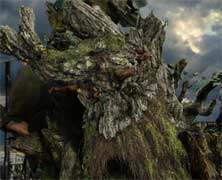 All his life Tolkien loved trees. In his childhood he dreamed, they could have mind, speak to each other and even move. And his dream came true as we can see it in his works (mostly in “The Silmarillion” and “The Lord Of The Rings”). When professor created reasonable trees, he desided to creat someone, who will look after them. That is how ents appeared. Ents look like trees, but they more reasonable, more movable and of course they are immortal. They are not fidgety, but very wise. Their speech is very slow and calm. Its manner (“Hrum, Hoom”) was copied with the deep bass of Luis, the best friend of J.R.R.Tolkien.
All his life Tolkien loved trees. In his childhood he dreamed, they could have mind, speak to each other and even move. And his dream came true as we can see it in his works (mostly in “The Silmarillion” and “The Lord Of The Rings”). When professor created reasonable trees, he desided to creat someone, who will look after them. That is how ents appeared. Ents look like trees, but they more reasonable, more movable and of course they are immortal. They are not fidgety, but very wise. Their speech is very slow and calm. Its manner (“Hrum, Hoom”) was copied with the deep bass of Luis, the best friend of J.R.R.Tolkien.
The elves

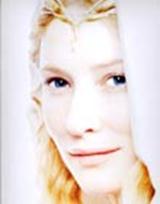 The elves in their appearance, whom we can see in the books of Tolkien were also mostly created by him. The roots of these characters are very ramified. Professor read a lot of information about all kinds of elves and finding something general tried to create something new. Finally he got immortal creatures, who can be killed only with a sword or they can pine away to death. They are tall, have perfect eyesight, bright hair and brave harts. They are wise, because of the memory they keep in their immortal mind. But elves themselves estimate their immortality as end-around infinity of analogical events, which exhaust and oppress them. But they have a dream to return to Valinor, country, where their immortality wont be so hard and difficult.
The elves in their appearance, whom we can see in the books of Tolkien were also mostly created by him. The roots of these characters are very ramified. Professor read a lot of information about all kinds of elves and finding something general tried to create something new. Finally he got immortal creatures, who can be killed only with a sword or they can pine away to death. They are tall, have perfect eyesight, bright hair and brave harts. They are wise, because of the memory they keep in their immortal mind. But elves themselves estimate their immortality as end-around infinity of analogical events, which exhaust and oppress them. But they have a dream to return to Valinor, country, where their immortality wont be so hard and difficult.
Lutien
Lutien Tinuviel (“Tinuviel” could be translated from Quenya as “nightingale”) is the most beautiful elven virgo in the whole Arda (The Earth). One day she was singing the hymn to Varda in the forest:
Ir Ithil ammen Eruchin (When the Moon is for us, the children of Eru,
Menel-vir sila diriel Like sky precious stone shines and saves,
Si loth a galadh lasto din! Let the flower and the tree listen in silence!
A hir Annun gilthoniel Oh, queen of the West, which light the stars,
Le linnon im Tinuviel! I sing to you, it’s me, Tinuviel.)
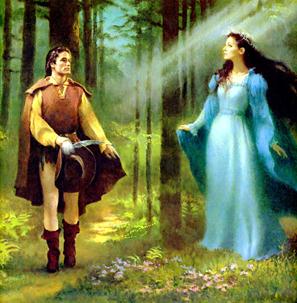 Beren, the bravest warrior herd this sounds and loved Lutirn in a moment. But he was mortal and she was an elf. That is why they could not be together. But their love was so strong, that Lutien managed to ask the goddess Varda to help them. And Varda helped them, so Lutien became mortal and shared the destiny of her sweetheart.
Beren, the bravest warrior herd this sounds and loved Lutirn in a moment. But he was mortal and she was an elf. That is why they could not be together. But their love was so strong, that Lutien managed to ask the goddess Varda to help them. And Varda helped them, so Lutien became mortal and shared the destiny of her sweetheart.
|
 referat-web.com Бесплатно скачать - рефераты, курсовые, контрольные. Большая база работ.
referat-web.com Бесплатно скачать - рефераты, курсовые, контрольные. Большая база работ.

